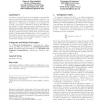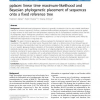539 search results - page 8 / 108 » Linear complexity of transformed sequences |
CORR
2012
Springer
12 years 3 months ago
2012
Springer
A sequence fn(q) is q-holonomic if it satisfies a nontrivial linear recurrence with coefficients polynomials in q and qn . Our main theorem states that q-holonomicity is preserve...
VLSID
2007
IEEE
14 years 7 months ago
2007
IEEE
? We give a new recursive rounding linear programming (LP) solution to the problem of N-detect test minimzation. This is a polynomialtime solution that closely approximates the exa...
CPM
1999
Springer
13 years 11 months ago
1999
Springer
In sequencing by hybridization (SBH), one has to reconstruct a sequence from its l-long substrings. SBH was proposed as an alternative to gel-based DNA sequencing approaches, but ...
BMCBI
2007
13 years 7 months ago
2007
Background: The pyridine nucleotide disulfide reductase (PNDR) is a large and heterogeneous protein family divided into two classes (I and II), which reflect the divergent evoluti...
BMCBI
2010
13 years 7 months ago
2010
Background: Likelihood-based phylogenetic inference is generally considered to be the most reliable classification method for unknown sequences. However, traditional likelihood-ba...


